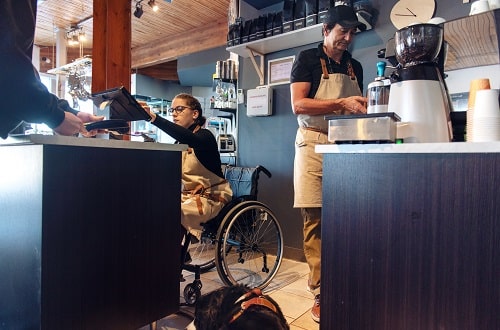The number of working-age people in the UK who are neither employed nor looking for a job rose again in the December to February period, prompting calls for more investment in training and a greater focus on the health and wellbeing of the nation.
News
Calls for wellbeing focus intensify as UK economic inactivity rate rises further
Figures released on 16 April by the Office for National Statistics (ONS) revealed that the economic inactivity rate for those aged between 16 and 64 years was 22.2 per cent in the period from December 2023 to February 2024. This is an increase of 0.3 percentage points, compared with the previous quarter, and is 1.7 percentage points higher than the pre-pandemic period between December 2019 and February 2020.
The unemployment rate also rose to 4.2 per cent between December and February – up 0.3 percentage points on the previous quarter and 0.1 percentage points on the pre-pandemic December-February period.
 British Safety Council chief executive Mike Robinson: "The number of people classed as economically inactive has remained stubbornly high since the pandemic, but today's figures show levels at their highest since 2015." Photograph: iStock/Joe Morris
British Safety Council chief executive Mike Robinson: "The number of people classed as economically inactive has remained stubbornly high since the pandemic, but today's figures show levels at their highest since 2015." Photograph: iStock/Joe Morris
The ONS attributed the economic inactivity rate increase to rises in both the number of students and the number of people with long-term sickness. It was also driven by those in the 16-34 age bracket, although this was partially offset by decreases in economic inactivity among those aged between 35 and 49 years.
"The number of people classed as economically inactive has remained stubbornly high since the pandemic, but today's figures show levels at their highest since 2015,” said British Safety Council chief executive Mike Robinson in response to the ONS figures. “This is being driven by too many people unable to work due to sickness or ill health, among other issues.”
Robinson reiterated British Safety Council’s call in its Health, Safety and Wellbeing Manifesto for the next UK government to appoint a dedicated minister for wellbeing and implement a National Wellbeing Strategy. This, added Robinson, would “help bring real focus to this problem and put health, safety and wellbeing at the heart of our economic growth policy".
The Resolution Foundation said that the UK was “the only G7 economy yet to return to its pre-pandemic employment rate”. The number of people inactive because of ill health hit a new record high of 2.8 million, added the think tank, and there has been a “worrying increase” in the number of people who don’t want a job.
“Tackling rising inactivity – and its impact on the public finances, the benefits system, and people’s wider health and wellbeing – is one of the biggest economic challenges facing both this government and whoever wins the next election,” said Resolution Foundation economist Charlie McCurdy.
Institute for Employment Studies director Tony Wilson described the latest UK jobs figures as “surprisingly poor”, adding that the rise in economic inactivity was the “most concerning” statistic.
“The trouble is that not enough people out of work are looking for jobs, rather than that people who are looking for jobs can’t find them. In other words, the weak labour market is holding back economic growth, not the other way round,” said Wilson. He would like to see faster movement on the rollout of the government’s planned Universal Support programme, and more investment in health, childcare and employment support.
“We need to go much further than this too if we want to reverse these trends, by more fundamentally reforming how we reach and engage with people who are out of work and, in particular, how we make our employment services more accessible, inclusive and supportive,” added Wilson. “We need to expect more from employers too, both to keep people in work and to improve access to work for those who may need more support.”
The UK government announced earlier in April that it would provide £1.5 million of funding to five projects aimed at boosting occupational health services for small and medium-sized businesses. It said the new support came as inactivity due to long-term sickness had increased by 735,000 since the pandemic.
One of the companies to receive funding, Kinseed Limited, is developing a cloud-based occupational health platform known as MediWork, which uses artificial intelligence (AI) to monitor health data and identify early warning signs of ill health.
“The innovative solutions developed through this funding will benefit businesses as we harness AI and technology to support a healthier and more productive workforce,” said minister for employment Jo Churchill.
Health and social care minister Helen Whately added: “Every year, many thousands of people take time off work – or leave work altogether – because of ill health. But at the same time, there are millions of people who are working with health conditions, often supported by occupational health services.
“A healthy economy depends on a healthy workforce. Making sure people can be healthy and stay in work is crucial for individuals, businesses and our country as a whole.”
NEWS

Employment rights bill passes into law, bringing 'work into the 21st century'
By Belinda Liversedge on 24 December 2025
Lawyers have joined unions to hail the passing of the employment rights bill into law as ‘the biggest upgrade on workers’ rights in a generation’.

Traffic wardens to work in groups 'for own safety' after facing abuse from drivers
By Belinda Liversedge on 24 December 2025
Traffic wardens in one local council are being sent out to patrol in groups because of threats and abuse.

Buncefield explosion 20 years on: legacy continues to protect people and places, says HSE
By Belinda Liversedge on 11 December 2025
On the day of the Buncefield fire’s 20th anniversary, 11 December 2025, HSE has reflected on the ‘profound changes’ the catastrophic fire has had on the major hazards sector’s management of risk.



